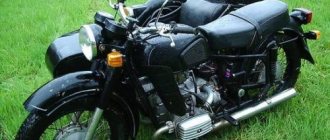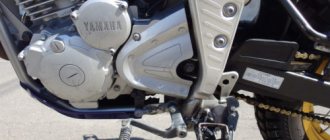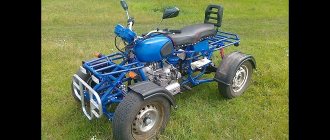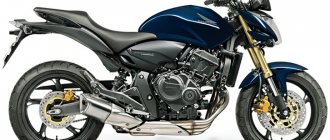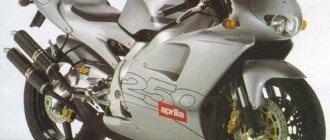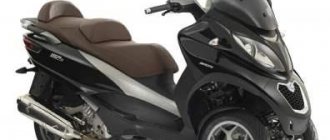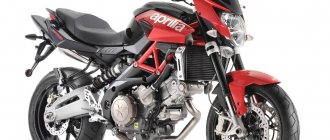This is a good road bike, friendly to new and experienced riders alike. The Yamaha XJ 600 Diversion should not be confused with the XJ 6 Diversion, since the latter clearly has more in common with the FZ-6 than with representatives of the Divershen series.
What is characteristic is that the motorcycle is not distinguished by a sharp start or a frantic increase in speed during the process. On the contrary, it accelerates smoothly, without rushing, which will protect many novice bikers. At the same time, the car is able to satisfy the needs of seasoned motorcyclists, for whom a comfortable ride is not enough, but dynamics are needed.
Dimensions and weight
If a person is of average height, he should look at the bike because it will most likely suit him. The XJ 600 Diversion has a seat height of 775 mm and weighs 180 kg without fuel. This is quite a bit for a road bike. However, the model copes well with gusts of wind, including headwinds.
Considering that gasoline consumption per hundred kilometers averages 6 liters, a tank volume of 17 liters is a completely acceptable solution. This circumstance makes the XJ 600 Diversion almost a touring motorcycle, at least it is definitely suitable for short picnic trips.
About the Yamaha FZS 600 Fazer motorcycle
Road motorcycle Yamaha FZS 600 Fazer
The Yamaha FZS 600 Fazer was actively produced from 1998 until 2004. It was soon replaced on the assembly line by the popular Yamaha FZ6 - just a modified version of the old motorcycle. Initially, the model was an urban motorcycle covered in plastic. The engine capacity is the classic 600 cc, which is quite sufficient by modern standards. The appearance was worked out by engineers in detail, but even now the FZS 600 has not lost its relevance. Russian bikers are very fond of this equipment for its modest cost, although it is still slightly inferior to the FZ6. Well, what can you expect from this type of equipment, produced since 1998?
The power unit in the old Yamaha sportbike is an in-line four-cylinder engine with a liquid cooling system. It was artificially derated, due to which the rated power dropped to 95 l/s and the torque was 61 nM. There is a minimum of electronics here, thanks to which, when you turn the throttle all the way, you will feel a kick “in the ass” and accelerate instantly. The FZS 600 stands out among its peers for its enthusiasm, four carburetors, liquid cooling, chain drive and a 6-speed gearbox refined to the smallest detail. The frame here is the simplest, made of steel, and a plastic fairing is installed on top of it. Initially, the model had an 18-liter gas tank, but later it was replaced with a 20-liter version. In 2002, the model was restyled and became the base model in terms of technical equipment and design for the future FZ6-S.
The explosive nature and excellent technical equipment allows the motorcycle to accelerate to hundreds in just 3.3 seconds with a maximum speed of 220 km/h. The modern Yamaha MT-09 has the same indicators. Due to its uncontrollable temper, the manufacturer decided to install front brakes from the popular R1. The suspension works without problems, and if necessary, it can be adjusted both at the rear and at the front. In the restyled version, the landing has become straight; there is an option to place it lying on the tank to achieve maximum speed.
1998 Yamaha FZS 600 Fazer
The dry weight of the motorcycle reaches 190 kg, which will not surprise motorcyclists. It seems heavy only statically, but during the ride the bike cuts through the air like a feather. Control obedience is ensured by the perfect operation of the suspension, but for this the suspension must be secured. Otherwise, the equipment will literally begin to “play around” and behave reluctantly. A strict control mode with all the tightening and adjustments does not allow the violent temper to break out!
Yes, the motorcycle belongs to the urban segment, but it can even be equated to a tourist. Everything is explained by the well-thought-out protection of the frame and main components, as well as the solid volume of the gas tank. Naturally, the manufacturer has provided for the possibility of partially modifying its brainchild by installing a higher windshield or touring panniers. The fit is very snug and collected, with plenty of seat space. Another notable feature of the motorcycle is the ability to change your body position for comfortable riding.
Thus, the technique still remains a clear representative of the manufacturer’s creativity. Most likely for these reasons, the phaser 600 was transformed into the FZ6-S. Yes, there were some shortcomings, but over time, professionals and engineering geniuses eliminated them. The 600th Yamaha phaser is an extremely popular model on the modern motorcycle market, which is why most motorcyclists are chasing it.
Yamaha FZS 600 Fazer
Post Views: 3,179
Similar articles:
Advantages and disadvantages
Based on reviews from Yamaha xt 600 owners, the motorcycle has an impressive list of advantages, including:
- Reliability.
- Low cost.
- Long lasting engine.
- Durable plastic casing.
- Flawless suspension and braking system.
- Comfortable seating position (even for drivers whose height does not exceed 170 cm).
The disadvantages of the motorcycle are the following:
- A weak frame.
- Air filter not suitable for off-road driving.
- Poor engine protection.
- The appearance of dents and scratches on the gas tank due to the slightest drop or other damage.
- The gas tank is small and unsuitable for long rides.
- Lighting devices do not always cope with their responsibilities.
In addition, some motorcyclists believe that the speed (maximum and cruising) of this model is low (155 and 140, respectively), and the rear brakes are not very effective.
In conclusion, it is worth saying that this motorcycle is quite suitable as a first equipment, precisely because of its positive qualities. Sitting on it, you are unlikely to feel 600 cubic meters and 43 hp. With.
Design solutions
The appearance of the Yamaha Phaser 600 was in perfect harmony with the stated characteristics.
Every line, curve and design element literally “screamed” about the swiftness and agility of the “steel horse”, fitting perfectly into the original concept of “comfort + versatility”.
The size of the bike allows it to feel great in heavy traffic:
- length - 209.5 cm;
- height - 108.5 cm;
- width - 75.5 cm;
- saddle height - 79.5 cm;
- wheelbase - 144.0 cm;
- ground clearance - 14.5 cm.
Among other things, 17-inch wheels (110/70-ZR17 front and 160/60-ZR17 rear), as well as almost ideal weight distribution along the axles (49 to 51%) add to the maneuverability of the 180-kilogram car.
The high saddle of the motorcycle is ideal for a rider of average height.
Its width allows you to sit with maximum comfort, and the footrests under the seat allow your limbs to be found intuitively.
The paired headlights look like the squinting of a cat's eyes and organically harmonize with other design solutions, while at the same time doing an excellent job with their main task.
A chrome exhaust muffler, a tinted windshield, neat rear-view mirrors, an original-shaped tank and an informative dashboard complement the image of a universal car.
In 2000, the Phaser 600 model underwent modernization aimed at increasing comfort during long journeys. As a result, the motorcycle received an enlarged (up to 20 liters) gas tank. A thicker seat, dual odometer (daily trip), dashboard clock, updated passenger handles, emergency stop signal, improved brakes and other suspension tweaks.
A couple of years later (2002), the tank was enlarged again, stainless steel pipes were installed, the dashboard and fairing were updated, fitting the motorcycle to the updated style of the brand and giving it a more modern look.
Chassis and brakes
The front telescopic fork measures 38 mm. Its stroke is 134 mm, which is quite a lot considering the road class of the motorcycle. The travel of the rear monoshock absorber is only 100 mm. The front brake here is good - it has a 320 mm disc and a single-piston caliper. But the rear disc here is, perhaps, purely symbolic, along with its single-piston caliper.
The appearance as a whole is no worse than that of the four hundredth model. The frame is made of steel, the wheels, although cast, look quite strict and modest, which is good for a road classic. In general, the exterior is typical for a representative of the class of the nineties.
Latest posts Popular The most interesting motorcycle news
you are reading the most popular news you are reading all the news you are reading the latest news read the most popular read all the news read the latest news
As a result of all of the above, the Yamaha SRX 600 model was not particularly impressive in dynamics, and in general its design was as simple as possible. Power was supplied by a carburetor, the frame was made of steel, and the transmission had five speeds. A telescopic fork was installed at the front, and two shock absorbers were located at the rear. This bike even had a kickstarter. The latter should be considered an advantage. But the bike did not last long in this form; already in 1991, the second generation of the Yamaha SRX 600 was released in the series, which had a modern appearance, a rear monoshock absorber and the absence of a kickstarter. In general, as you can see, there were no big changes.
In order to accelerate to one hundred kilometers, it will take at least 6.1 seconds, according to the data indicated in his passport, and the highest possible speed is 170 kilometers per hour. True, such “single-barrel” motors are characterized by the disadvantages listed above, which can be noticeable at high speeds, and the Yamaha SRX 600 model was no exception. For this bike, a comfortable cruising speed is about 120 kilometers per hour and six liters of fuel, while reaching a speed of 140 kilometers per hour, eight liters of gasoline are already required. To our great joy, the motorcycle is not particularly demanding on gasoline, and is happily ready to digest any fuel.
Also, the rear suspension of the restyled version of the Yamaha SRX 600, which is more common, can cause doubt. It has the ability to adjust the preload of the monoshock absorber and a free play of only ten centimeters. The 36mm fork, which has a free travel of only 13.4 centimeters, is also difficult to classify as examples of modern technology, even if you take into account the year of manufacture of the motorcycle. Even in the early nineties, more modern models could be found. However, the Yamaha SRX 600 motorcycle was popular with its relatively low cost and reputation as an absolutely indestructible vehicle.
Today, such an iron horse has become very popular among customizers who like to transform this bike into something impressive, since the affordable price and simplicity of the original design contribute to this. At the same time, there are also enough motorcyclists who like this motorcycle in its original form. The arguments in favor include reliability, simplicity and retro style. As arguments against, we should highlight low power, archaic instead of retro styling, sluggish dynamics, weak brakes and indistinct power. However, if this motorcycle had not sold well, then it would not have been able to survive on the assembly line for twelve whole years, right? This means that the Yamaha SRX 600 motorcycle model has its own advantages, which, in principle, we have all listed for you.
Specifications
As mentioned above, the basis for the Yamaha Fazer 600 model was a traditional, proven duplex cast frame, on which an equally reliable R6-based powerplant with an outstanding sporting pedigree is mounted.
More detailed information about the characteristics of the Yamaha Fazer 600 is presented below.
| Motor type. | 4-stroke, 4-cylinder, in-line DOHC. |
| Working volume. | 599.00 cm3. |
| Stroke and diameter of the piston stroke. | 44.5 x 65.5 mm. |
| Compression. | 12.2 to 1. |
| Power (max). | 98 l. With. (12,000 rpm). |
| Kr. moment (max). | 63.1 Nm (10,000 rpm). |
| Speed (max). | 214 km/h. |
| Ignition. | TCI. |
| Clutch. | Multi-disc. |
| Launch. | Electric. |
| Transmission. | 6-speed, constant mesh. |
| Drive unit. | Chain. |
| Acceleration 0-100 km/h. | 3.5 seconds. |
| Dynamics 60-140 km/h. | 11.8 seconds. |
| Fuel consumption. | 0.64 liters per 100 km. |
Yamaha XT 600 - review of a unique motorcycle, photos and videos
For many years, one of the most popular models of the Japanese motorcycle manufacturer YAMAHA has been the XT600 model, developed back in the distant eighties of the last century. Over time, the motorcycle has evolved from a fairly highly specialized enduro into an almost absolutely universal device for traveling on and off the road. This was appreciated by both critics and fans of motorcycles by increasing the number of purchased units.
Performance characteristics of the Yamaha XT 600
Regarding the motor, it is worth noting that its original design was created back in 1975, and since then has not undergone any major changes, which, of course, has a positive effect on the reliability and ease of maintenance of the motorcycle. Although it is precisely this parameter that surprises many, because so many years have passed, new technologies and methods of their implementation have appeared, and the engine is still reliable and simple. The “heart” of the motorcycle
The power unit, developed for the famous Paris-Dakar trophy raid, was brought to almost ideal characteristics by the nineties of the twentieth century. Perhaps this is precisely the key to the genius of the developers, whose brainchild is still being used with great success.
A unique power system with two carburetors operating on different principles and responsible for different intake valves provides the engine with all the necessary mixtures for smooth and long-lasting operation in any conditions. This is a very significant plus when choosing a motorcycle in principle.
An absolute drawback of the power system is the design of the air filter, which is too susceptible to dirt and dust, which significantly reduces the service life of this important element.
The engine capacity is a very sufficient 596 cubic centimeters , which allows it to achieve a power of 42 horsepower at 6250 rpm. The engine power is more than enough to overcome both asphalt roads and very serious off-road conditions.
Chassis
Years of improvements and changes have almost completely erased serious off-road qualities from the motorcycle’s chassis. A soft suspension with small travel cannot support aggressive off-road driving that includes jumps and other motocross elements. At the same time, the motorcycle easily and at high speed overcomes difficult sections of public roads. The relative softness and low energy consumption of the suspension makes driving over long distances more comfortable. You can purchase high-quality spare parts on the pages of the online store astar.ua. The prices pleasantly surprise even experienced drivers, who know well that in our time it is quite difficult to find high-quality spare parts at an affordable price. A gas tank volume of 15 liters and an average fuel consumption of 4 - 4.5 liters per 100 kilometers provide a sufficient range for travel, while the possibility of installing tuned tanks of a larger volume brings autonomy to very respectable indicators.
In general, the age of the model has had a very positive effect on the number of various accessories that allow you to “tailor” the motorcycle for a variety of use cases.
Behavior on the road
The design of the YAMAHA XT600 quite strictly determines the environment of its use. It is very versatile, but completely unsuitable for cross-country trails. The engine's power and thrust are more than enough to overcome serious off-road conditions that do not involve jumping.
The behavior of the motorcycle on the road is extremely predictable. He forgives the pilot for mistakes that are unforgivable for others, for example, a high-speed pull to the side of the road to avoid an obstacle. At the same time, the motorcycle suspension gives the driver the opportunity not to pay attention to uneven road surfaces and the presence of stones and sand on it.
This behavior immediately puts the YAMAHA XT600 in the category of motorcycles recommended for novice pilots. Driving errors, such as the front wheel skidding during hard braking, do not lead to the expected fall.
Minor disadvantages of the motorcycle
The versatility of the motorcycle leads to some disadvantages, but they are not very critical. For example, it is not always convenient for moving around the city due to the insufficient efficiency of the braking system on asphalt. At speeds above 120 kilometers per hour, there is uncertainty in the behavior of the rear axle, the motorcycle wobbles noticeably. This is an inevitable price to pay for a soft suspension and frame that allows you to comfortably overcome bumps.
The engine power, which is quite sufficient for conquering off-road terrain, despite this, does not give the pilot the opportunity to actively move in urban conditions. The low maximum speed and downright slowness in its acquisition do not make the YAMAHA XT600 driver a leader in urban racing.
Available engine tuning with replacement of the piston group and exhaust system will certainly add the missing strength to the engine, but will significantly reduce its reliability that it is easier to immediately consider purchasing a more powerful device if YAMAHA is not satisfied with this default parameter.
But the undeniable advantage is reliability and ease of maintenance. After installing a reusable air filter, all technical work on the engine is limited to regular oil changes.
But the most obvious and serious drawback of the YAMAHA XT600 is its imperfect headlight. This problem is noted by absolutely all owners of this motorcycle and is not cured even by the now popular xenon installation. It is quite possible that the developers will eliminate this flaw, although it is quite strange that this “disease” has not been cured for so many years.
Related materials:
- Original Yamaha FZ8 motorcycle - photos and videos
Motorcycles of the “sport” class traditionally evoke respect and veneration, because in addition to the beauty of the unit itself, the driver of the motorcycle and his driving skills were also admired. Riding this...
- Motorcycle Yamaha Royal Star 1300 - full review, photos and videos
First of all, it should be said that the Yamaha Royal Star 1300 motorcycle will be an excellent option for those bikers who love long journeys. This two-wheeled “iron”…
- Yamaha XT660Z Tenere - review, technical specifications, photos and videos
Another model of the Japanese motorcycle manufacturer YAMAHA, which traces its lineage back to the legendary winner of the Paris-Dakar trophy raid of the seventies, is the YAMAHA XT660 Tenere. ...
- Yamaha Midnight Star motorcycle - full review, photos and videos
It's no secret that technological progress is constantly moving forward, opening up new opportunities that were unavailable before. For example, a few years ago, a little...
- Review of the Yamaha GTS 1000 motorcycle - photos and videos
There are different models among motorcycles, differing both in design and in their technical characteristics. There are both city bikes and sports bikes, as well as specially…
Bike features
What's so special about this model? The answer is simple: the developers were driven by the idea of creating the most comfortable motorcycle possible. Accordingly, the body of the motorcycle was made larger, and a royally chic chair was installed on it.
Ergonomics are at their best, since both the mirrors and the panel board occupy an ideal location. Don’t forget about the ride quality of the bike, which allows you to feel great both in city traffic and on a pleasant ride on the highway.
The braking system is balanced so that you can accelerate quickly and brake effectively.
An interesting feature of this model is the variety of colors, because after each change the developers took the liberty of choosing non-standard colors:
- Red;
- Black;
- Green;
- Violet;
- Silver gray;
- Blue;
- Yolk color;
- Burgundy;
- Sometimes the colors had a characteristic metallic tint
A very unexpected motorcycle model Izh Junker, the latest developments in domestic motorcycle production.
If we're talking about all-terrain vehicles, take a look at the Chinese ATB Irbis 250 ATV:.
